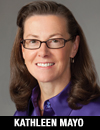A Fearless Leader: Cablevision’s Mayo Doesn’t Shy From the Big Tasks
Kathleen Mayo
Executive Vice President, Consumer Telecommunications Services
Cablevision Systems
Kathleen “Kip” Mayo, executive vice president of consumer telecommunications services at Cablevision Systems, has had two dream jobs in her lifetime, and she has company CEO James Dolan to thank for both of them.
Mayo joined the New York-based MSO in 1997 to head up operations in Massachusetts, including its Boston property. But her experience had mainly been in finance, and she had no cable experience before taking on that post. She credits Dolan with seeing something in her that even she couldn’t see.
“When I think back on it , Cablevision has given me two career opportunities of a lifetime,” Mayo said. “The first one back in 1997, no one in their right mind would have hired me as GM. … The appeal for me was, it was the first time in my career, at the ripe old age of 38, to have full [profit-and-loss] responsibility.”
That was pretty important for a finance person. Born and raised in Pittsburgh, Mayo graduated from West Chester University with a sociology degree in 1980 and got her MBA from Temple University in 1986. Prior to Cablevision, Mayo had held various cash management and finance positions at Western Union, the Franklin Mint and Intelligent Electronics, a computer remarketer with offices in Exton, Pa., and Denver.

It was while she lived in Colorado that Mayo got to expand her athletic aspirations — she is an avid runner and biker and in Colorado added hiking 14,000-foot peaks to her repertoire. Her nickname? That she’s had practically since birth, when her older (by 16 months) sister Diane tried to say Kathy and it came out “Kip.”
Cablevision sold the Cleveland and Boston systems around 2000, but Mayo’s true calling came in 2001 when Dolan offered her the second opportunity of a lifetime: heading up all of the MSO’s field operations and customer-service businesses.
Multichannel Newsletter
The smarter way to stay on top of the multichannel video marketplace. Sign up below.
It was a heady time, since Dolan had a plan to totally revamp Cablevision’s operations, rebuilding the plant to state-of-the-art technology and setting the stage for the launch of telephony, which would become the anchor of cable’s first mega-successful triple-play offering.
It was also a big responsibility. As senior vice president of consumer telecommunications services (she was promoted to executive vice president in 2005), Mayo was responsible for all field operations, service, outside plant, security auditing, customer service, 15 call centers, 50 walk-in centers and the billing organization. Her unit now has 8,000 employees and a $900 million annual budget.
“Jim had a whole lot more confidence in me than I did,” Mayo said. “I was nervous about it.”
While Mayo is modest concerning her own success, her peers are quick to point to her intelligence, her extreme attention to detail and her business savvy.
“She is absolutely fearless,” said Cablevision cable and communications president John Bickham. “There isn’t anything that scares her. No matter what the challenge, there is no fear of anything.”
That fearlessness, and a knack for getting things right the first time, according to Bickham, has helped ease the path for Cablevision’s strong operational performance. Today, the company has the highest digital penetration (at 94.2%), the largest high-speed Internet penetration (52.5%) and the highest telephony penetration (41.7%) in the industry.
Mayo admits it hasn’t been easy, and when she started the task in 2001, it seemed downright impossible. Like the rest of the industry, Cablevision had a pretty poor customer-service reputation. But Mayo said that Dolan’s vision, coupled with that of chief operating officer Tom Rutledge, who joined the company nine months later in 2002, gave her the blueprints for the task at hand.
Senior vice president of customer service Rocky Boler — who’d run call centers for Barnes & Noble, Sears, Pitney Bowes and IBM, and who Mayo hired in 2002 — had another word for the task: “monumental.”
“People have, quite frankly, a different opinion of cable and certainly of Cablevision as a result of some of the things that we were able to accomplish,” Boler said.
Mayo said the process was broken down into three separate steps — the first was standardizing all of the operations. The second involved consolidating 15 call centers into six (and eliminating outsourcing), splitting the field operations into seven areas and placing seven different vice presidents to head up each unit. Mayo said the idea was that, even though Cablevision is technically one system, it coves a large area — 3.1 million customers in New York, New Jersey and Connecticut. And it was essential to ensure that managers were as close to their local operations as possible.
The third piece involved customer service operations and built on an early idea of Dolan’s to give service reps the tools to be experts in specific product and business areas.
And while Cablevision has made huge improvements over the years, Mayo said she is not a big fan of ultra-specific targets. While the organization measures itself through a series of performance metrics — mainly involving customer satisfaction — she is not a big fan of using hardcore metrics for defining forward progress.
“I don’t care what the average handling time is,” Mayo said. “I want the customer to be satisfied and I don’t want them to have to call back.”
